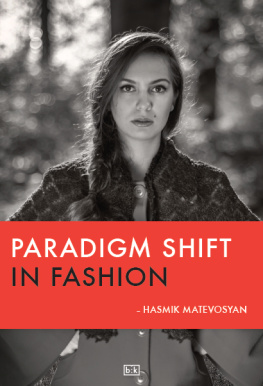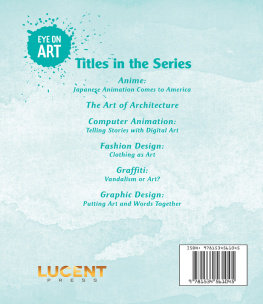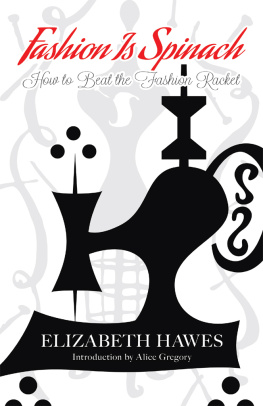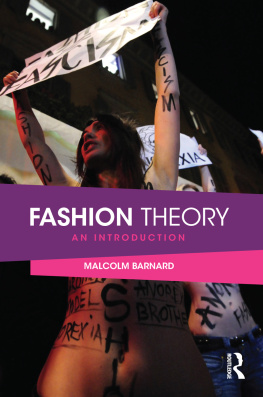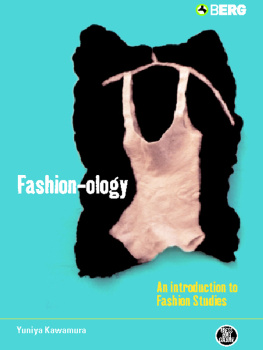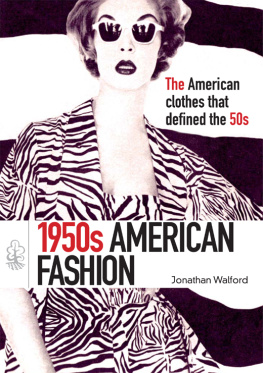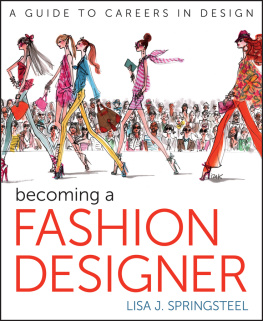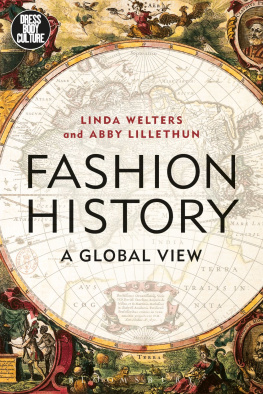Hasmik Matevosyan
PARADIGM SHIFT
IN FASHION

colophon
This is a publication of Booklight publishing services. An overview of all our publications (both printed and e-books) can be found on our website: www.booklight.nl/boeken
Booklight is een nieuwe, dienstverlenende uitgeverij voor beginnende auteurs en professionele schrijvers. Al onze boeken verschijnen als paperback en als e-book.
We kiezen er bewust voor e-books aan te bieden zonder DRM-kopieerbeveiliging, omdat we het voor u niet onnodig ingewikkeld willen maken om onze e-books aan te schaffen. Uiteraard gelden ook voor e-books copyrights. We vertrouwen erop dat u dit copyright respecteert, zodat wij onze e-books DRM-vrij kunnen blijven aanbieden en onze schrijvers krijgen waar ze recht op hebben.
Zie voor een overzicht van al onze e-books: www.booklight.nl/boeken
Check Hasmik's website www.hasmikmatevosyan.com for recent blog posts and more information.
2014 Hasmik Matevosyan / Booklight
ISBN 978 94 91472 756
NUR 452
Cover design: We love it when a plan comes together
Text design: Studio Drukwerk
Cover photo: Armando Ello (model: Merve Acikgoz)
Authors photo: Kevin Kwee
Illustrations: Hasmik Matevosyan (drawings and schemes) Samy Andary (drawings in the case study Patch)
Final editing: Hope Visser-Mulder
Alle rechten voorbehouden. Niets uit deze uitgave mag, in welke vorm of op welke wijze dan ook, worden verveelvoudigd, opgeslagen in een geautomatiseerd gegevensbestand of openbaar gemaakt zonder voorafgaande schriftelijke toestemming van de uitgever.
All rights reserved. No part of this book may be reproduced, transmitted or stored in any form or by any means without written permission of the publisher.
www.booklight.nl
TABLE OF CONTENTS
Acknowledgements
Crowd-funding
It wouldnt have been possible to publish this book without the collective financial support of my friends and colleagues from different countries. During February and March of 2014 I had set up crowd-funding for the finalization of my research and the publication of this book. I would like to dedicate a few lines to thank everybody in the Netherlands, Spain, Armenia, United States and Norway who have supported me by pre-ordering the book and sharing the link to the crowd-funding campaign through social media.
I would like to thank Armando Ello for his valuable help in filming and editing the video that we used for communicating the message.
In addition, Nudge (sustainable consumers platform) offered to help by introducing me to Frits Snijder, an accountant who helped me understand how business models work and gave me tips for the book.
Samy Andary is my partner in the case study Patch The Ideal Sweatpants , which we developed for testing the design system. I would very much like to thank him and Sophie Buiting for their creative ideas in the communication aspect between the Patch community of sweatpants lovers and ourselves. Communication was one of the key factors toward building a community of almost five hundred people all over Europe, even America. The majority of this international community actually helped us design the sweatpants by providing us with feedback on many different levels.
This book could not have happend without the help of none other than my Publisher, Booklight. I would like to thank Suzanna van der Laan for her service, support and the information shes passed on to me throughout the past months.
Humana sponsoring
Humanas director, Marc Vooges has supported the case study Patch by sponsoring the project with over two hundred hoodies. The hoodies were used as our material for the sweatpants. Samy and I would like to thank Marc for trusting us and supporting our plans.
Emotional support
I would especially like to thank everyone who has supported me in writing this book, and given me the needed push to raise the standard of the content, as described in the following pages, to a higher level. Its overwhelming to be surrounded by great friends and loving family who believe in me and support me unconditionally.

Introduction
Preface
Fashion and sustainability might at first sight seem like direct opposites, since fashion is mostly about change and sustainability about durability.
Although fashion is about change, durability can play a large role in it. Fashion influences the way we perceive our body and the clothes which we choose to put on can even affect the way we feel and how we act in our daily lives. Everybody is connected to fashion one way or the other, even those who are not aware of it. We all wear clothes and will usually try to pick the right outfit for a certain occasion. And yet, the production of clothes for global distribution takes place for the most part in non-Western countries, not by robots but by working people, something that most of us seem to forget.
One undisputed fact is that the fashion industry today causes tremendous amounts of pollution that has a direct impact on the lives of many people around the world. Eighty billion kilos worth of textiles are being produced annually on a global scale. This makes the textile industry the second biggest water consumer, after agriculture. Its not just about water though. There have been incidents of cotton farmers dying due to poisoning by dangerous pesticides. In the bottom links of the production chain, alarmingly large numbers of clothing manufacturers are forced to work in inhumane and dangerous conditions. I could comment on the problems and describe them from every possible angle but Id rather not. This book will focus on suggesting realistic improvements for the industry which are based on effective cooperation. Fashion brands will learn how to create a stakeholders map and calculate for themselves what their impact is, on the environment and on the people working for them. Only by knowing where the brand stands today, will it be able to measure its improvements in the years to come. If you as a reader have recently been slapped in the face by the truth concerning the production, use and disposal of clothes, I would like to recommend some books to you, other than this one, which you should also read. Several notable books have been published on fashion and sustainability and I would highly recommend the ones below.
- Sustainable Fashion & Textiles : Design Journeys, Kate Fletcher, 2008
- Beyond Green, Artez Press, 2008
- Talking Dress, Marieke Eyskoot, 2012
- Mode voor Morgen, Lynsey Dubbeld, 2012
- Fashion and Sustainability: design for change , Kate Fletcher, 2012
These books give an extensive description of the negative impact of fashion on the environment and the people involved. They also provide an overview of organisations which are specialized in solving one or several of the problems the fashion industry is facing.

The focus of this book
The book you are reading was written for everyone who is already aware of the problems described above, and is searching for major solutions that can be implemented without compromising brand growth and development. In the past four years Ive been to numerous events in the Netherlands and Germany which were aimed at raising awareness about these problems. They discuss issues such as pollution due to water, energy and chemical use, child labour, unfair labour, suicides, consumers ignorance and more. They also showcase inspiring brands as examples to follow. Unfortunately many brands which want to get to the same place, often dont know how, even after they have recognized the various problems. Clear follow-up steps are necessary for people and companies to start utilizing techniques toward real solutions. I believe awareness is the first step towards searching for solutions and serves as a preface for further improvement. The general flaws were fully realized somewhere in the 90s and since then, many companies and individuals have been doing their best to spread knowledge and raise awareness on the matter. I would like to take this opportunity to sincerely thank all the companies who do their best to inform and motivate consumers to re-think their buying behaviour and encourage brands to make smarter production choices toward a better fashion, and subsequently a better world.

